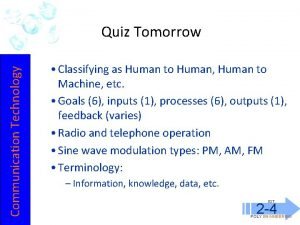Networked carers new information communication technologies and carers

- Slides: 1

Networked carers: new information & communication technologies and carers of people with dementia University of Warwick. Lead researcher: Dr John Powell Dementia • Affects over 750, 000 people in the UK • Over 870000 people by 2010; 1. 8 million by 2050 • 5% of people over age 65; 20% of people over age 80 • Majority cared for at home Carer issues: • Socially isolated, lack information • Increased psychological morbidity, especially “distress” • Lower self care including reduced “healthy” behaviours • Underuse of services, financial hardship New ICTs & carers: theoretical benefits • EMPOWERMENT: expert carer; informed/inform others; organise socially/politically. • SUPPORT: from/to professionals; from/to peers; hope, understanding & empathy. • ACCESS: services – health; social; other e. g. commercial. • REMOTE CARE: monitoring – user-controlled; automated. • NEW TOOLS: Smart homes; assistive devices. Aim Understand how networked society changes experience of caring for people with dementia and how networked ICTs can support carers’ role Objectives Identify current/predicted use of networked technologies (NTs) by carers Identify attitudes and beliefs of dementia carers towards NTs Identify benefits and disadvantages of NTs, now/ and future Identify barriers and facilitators to implementation of NTs in dementia care Disseminate findings to guide implementation of NTs in dementia care Methods 1. Scoping work- literature review - stakeholder interviews 2. Interviews (semi-structured & vignettes) with carers. 3. Workshops – local carers, local practitioners, national policymakers & industry Information and Communication Technology Research Initiative www. ictri. port. ac. uk TASMINH 2: Telemonitoring and Self Management in Hypertension University of Birmingham. Lead Researcher: Dr Richard Mc. Manus Why Hypertension? • Key risk factor for cardiovascular disease • 5 mm. Hg reduction in systolic BP = reduction of stroke risk by 15 -20% and coronary heart disease risk by 5 -10% • Hypertension is common: 30 -40% of adults affected • Second most common reason for an adult to attend their GP • Hypertension is poorly controlled in the community The Trial • RCT: Self Management vs Usual Care • Patients identified by practice computer search • Invited to attend practice based baseline clinic • Randomisation to intervention or usual care • Practice GPs determine management Intervention: Self monitoring – 1 st week every month Outcomes • Follow up at 6 & 12 months • Main outcome Systolic Blood Pressure • Secondary outcomes: Diastolic BP / costs / anxiety / health behaviours / patient preferences / systems impact • Recruitment target 480 patients (240 x 2) • Sufficient to detect 5 mm. Hg difference between groups Qualitative sub-study • Generate data regarding acceptability and generalisability of self management into daily practice • Interviews with patients, carers, health professionals and technology reps • Grounded theory methodology with constant comparative analysis The Policy Research Programme, Department of Health commissioned six projects to provide more evidence on the role of ICT in healthcare, the effects on quality of care and ultimately the quality of life of patients using ICT solutions for their health needs Modelling the impact of service innovation in Stroke Care Tanaka Business School: Imperial College. Lead researcher: Dr Benita Cox Background • Stroke is the largest cause of severe disability in the UK. • With a growing ageing population it is predicted to put a significant strain on resources in the healthcare system • New policy initiatives have been announced, aimed at improving stroke care services • Innovations in technologies, care practices and philosophies could help Aims • To map the acute and community care journey for stroke patients and identify possibilities for improvements • To investigate service and technology innovations that might help, and explore factors that might assist or impede their introduction Methods Case study: one acute trust and one PCT in South London. Interviews Simulation modelling and cost analysis 12 month study from December 2006 Preliminary model of local stroke care service delivery

